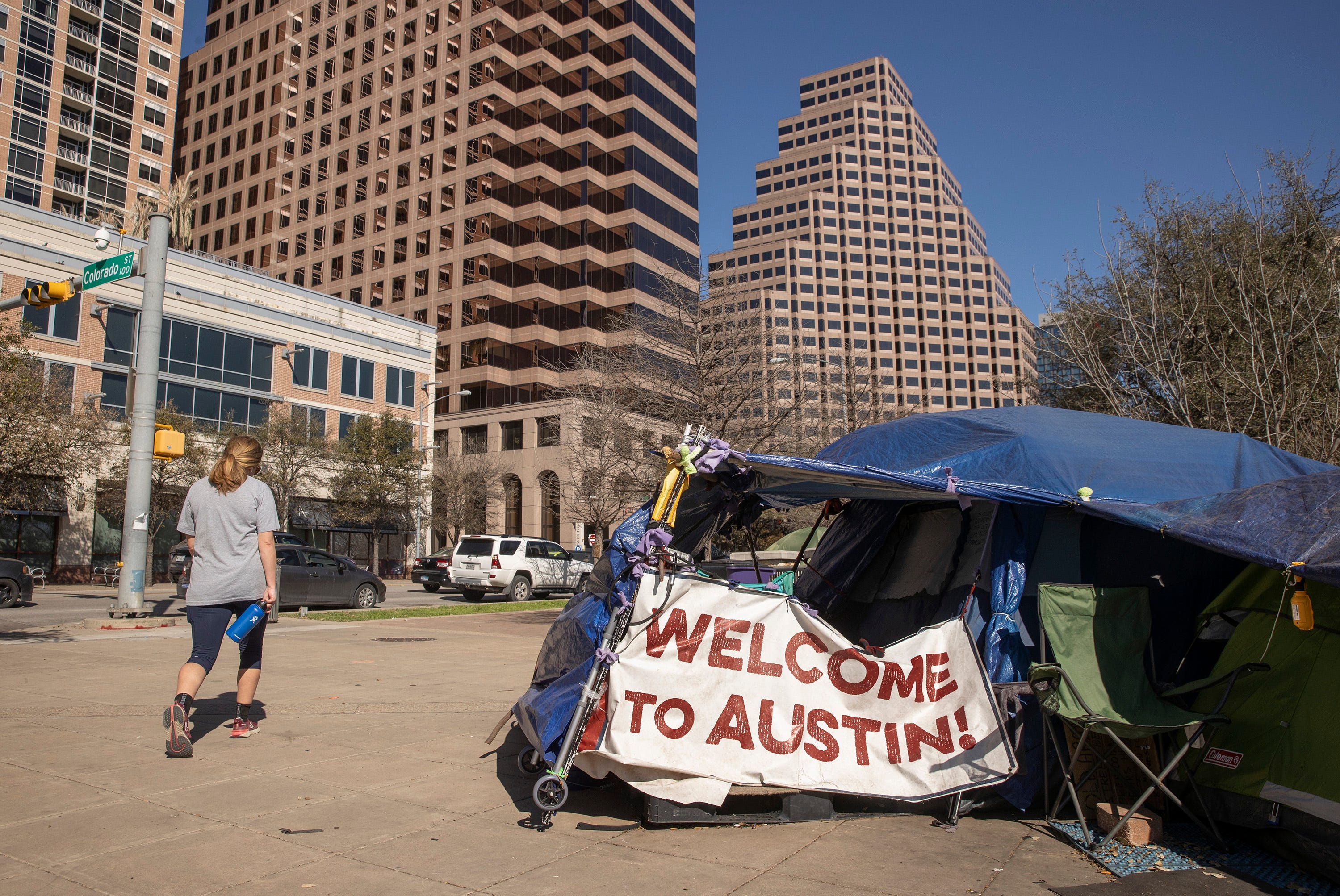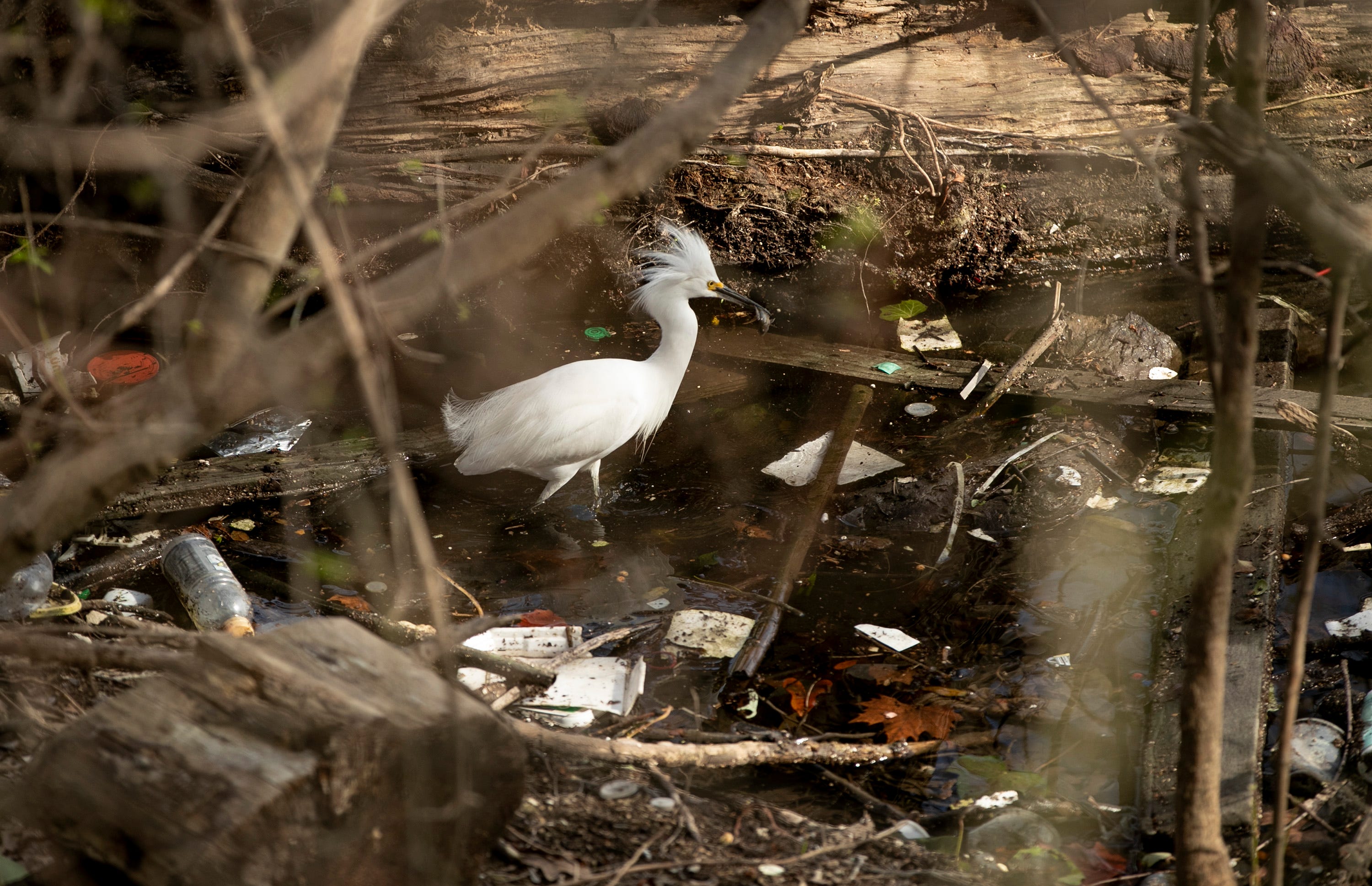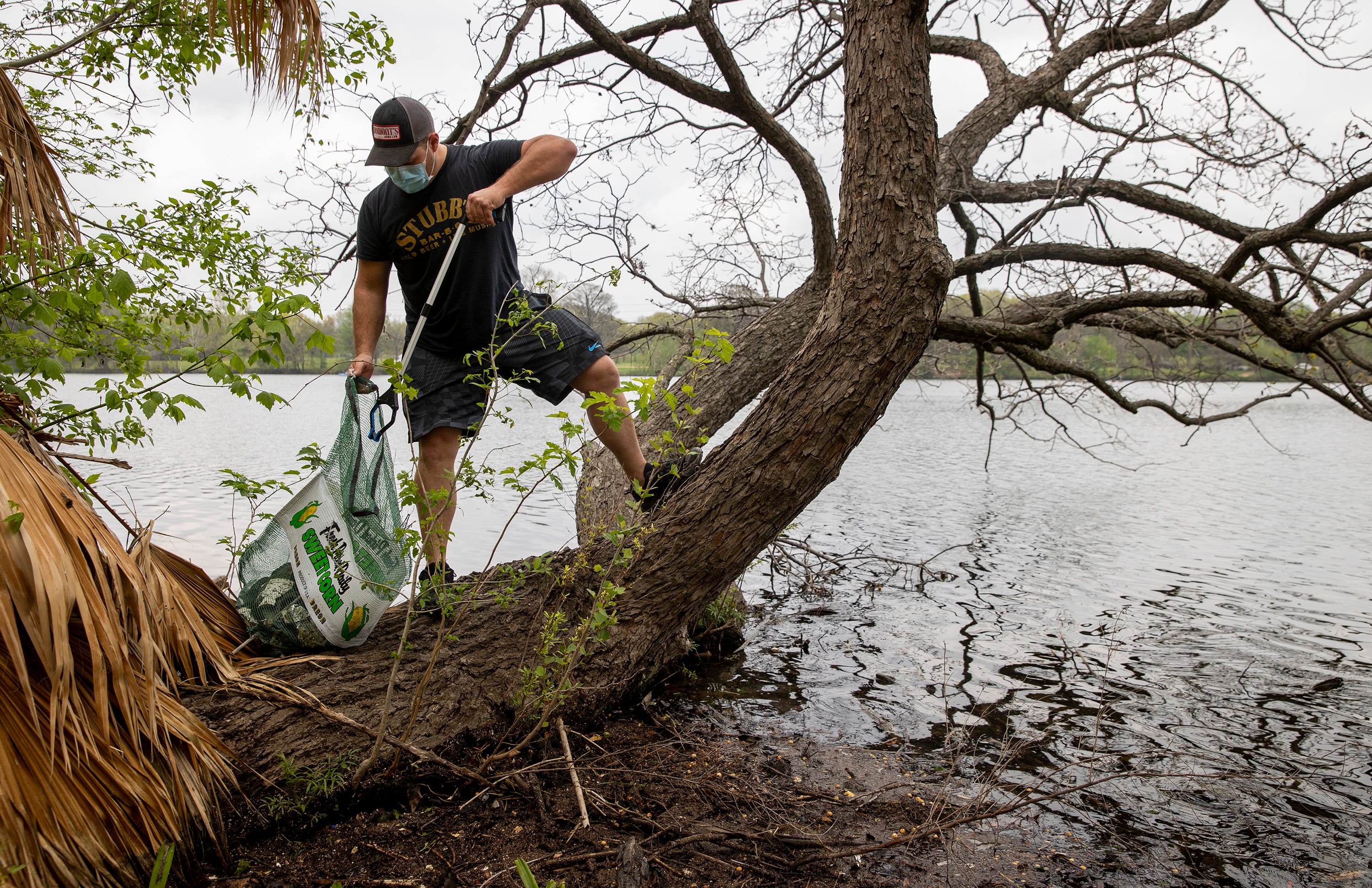Among the locations hit hardest by Austin's homelessness crisis is the Ann and Roy Butler Hike and Bike Trail — the popular 10-mile loop along Lady Bird Lake that was supposed to be protected against the city's explosion of tent encampments.
When the Austin City Council approved a controversial measure in June 2019 canceling an ordinance that had made it a criminal offense to camp in public, it came with the explicit understanding that city-owned trails and parkland would remain off-limits.
But it hasn't worked out that way.
Since early 2020, dozens of tents have popped up along or near the trail in violation of the camping ban.
But rather than issue citations or direct tent occupants to move, the city during the COVID-19 pandemic has opted to follow guidelines from the U.S. Centers for Disease Control and Prevention that urge letting people who are living in encampments stay where they are to minimize spread of the disease.
Their presence inflamed an already sizzling political divide in the city by tarnishing a trail that has long symbolized the city's bustling outdoors scene the same way Sixth Street has symbolized the city's nightlife. The trail attracts 4.4 million visits a year.
The influx of homeless campers has also happened around the same time the city reduced the amount of time spent cleaning Lady Bird Lake by 75% — a reduction that, combined with the increase in campers, led to trash piling up in the water and along shorelines.
In a 12-month period ending in March, Austin's 311 nonemergency service line received 463 service requests with complaints related to transients on city-owned trails. The requests — which included all trails, not just the one along Lady Bird Lake — involved camping, as well as other potentially unlawful actions, such as trespassing after hours.
'A symptom of the problem': How homeless camps are impacting Austin's hike-and-bike trail
Austin has seen more homelessness encampments on the hike and bike trail since 2019. Some trail and city residents blame one entity for the situation.
Ana Ramirez, Austin American-Statesman
“This COVID-19 public health crisis has hit the homeless community particularly hard," city spokesman Andy Tate said in a written statement. "While the city has made significant strides over the past year in identifying services, shelter, and long-term housing opportunities for those in need, we must continue working together to help our most vulnerable community members. That includes largely following CDC guidance to allow people who are living unsheltered to remain where they are to minimize community spread of the disease and maximize access to services."
The rise in trail camping coincided with a reduction in capacity at homeless shelters, which faced their own social distancing considerations amid the pandemic and had to turn away people looking for a place to stay.
On May 1, Austin will hold an election headlined by Proposition B — a proposition that, if successful, would drastically alter the state of homelessness in Austin by again making it a criminal offense to camp in public. If approved, camping would be prohibited everywhere — not just on parkland and other areas currently designated off-limits.
The election comes nearly two years after the City Council voted to strike down the 23-year-old ordinance that made such camping unlawful — an extraordinary decision framed by Mayor Steve Adler recently as becoming the largest political issue in Austin in the past 50 years.

Sanford Howard, who says he became homeless when his wife left him 16 years ago, said he understands the frustration over transients living on the trail. He said he recently began staying in an encampment above the trail near East Caesar Chavez after getting kicked out of a boarding house.
"But where else are we going to go?" he said.
In a recent count of tents on or adjacent to the trail, about a dozen were grouped together near the Shoal Creek entrance point. A handful more were scattered at the opposite end of the trail east of Interstate 35. Near Rainey Street, a man without a tent slept on the ground in a sleeping bag.

The largest encampment, with about two dozen tents, was below Caesar Chavez Street near Congress Avenue. On a weekday afternoon in early March, a woman who gave her name only as Jessica was talking with the American-Statesman about the events in her life that led her to become homeless when she was interrupted.
Passing by the encampment, a woman riding a bicycle looked up at a group of transient people Jessica was with.
"Go get a job!" the cyclist yelled, looking back as she peddled along the trail. To ensure her remark registered, she repeated it, "Go get a job!"
"F--- off, lady!" Jessica fired back.
About a month later, on April 1, a fire at the encampment spread to and damaged the historic Buford Fire Tower. Police arrested 58-year-old David Rosenblum on charges of first-degree arson.
Council Member Kathie Tovo — whose district is home to much of the trail — said her office hears often from residents and business owners objecting to camping along the trail.
She said many of those complaining are unaware the city is allowing it during the pandemic.
"We're definitely hearing a lot of feedback," Tovo said.
Not just tents, but trash
The arrival of the tents coincided with the city rolling back taxpayer-funded services aimed at keeping the trail clean and safe, exacerbating tensions.
In another controversial political decision, the City Council last summer approved a budget that cut 150 vacant officer positions from the Austin Police Department and put a pause on adding new officers by temporarily closing the police cadet training academy.
Police Chief Brian Manley responded by eliminating many specialty units — including the 31-person parks unit — and moving those officers to street patrol. That left the trail absent of officers who in the past cruised the path on bicycles on mornings before sunrise.

It's hard to say if crime has increased since the arrival of the encampments, because the Police Department says it does not have the ability to isolate trail-related calls. Street patrol officers now handle calls for activity on the trail.
Mike Pearce, who owns a boat cruise business on Lady Bird Lake, said the tents and trash have made his job more difficult.
"We're trying to do narration and promote our city, and there are all these tents setting up," said Pearce, who has owned Lone Star Riverboat Cruises for 34 years.
Months before Manley eliminated the police parks unit, the city scaled back trash pick-up services both on the trail and in the lake.
On a recent afternoon, the lake east of Interstate 35 was littered with drink containers, fast food packaging and a golf bag.
The trash is disturbing. It's understandable with the amount of people displaced here, the amount of people with mental illness. I don't know what the solution is.
In other areas laid a vacuum cleaner, a computer desk chair and a chair inscribed with the name Isabella. In some spots, trash interfered with birds and turtles searching for a shaded resting place.
According to Tate, the city spokesman, the parks department picks up trash along the trail only once a day because of limited staffing levels. He said some employees assigned to collect trash have missed work because they or a family member was exposed to COVID-19. Due to the infrequent care and the large number of visitors, trash regularly overflows from receptacles and onto the trail during busy weekends.
On a recent day, Philae Amenti, a longtime Austin area resident and trail user, stared disapprovingly at a T-shirt left at a vacated campsite underneath the Ann W. Richards Congress Avenue Bridge.
"The trash is disturbing," she said. "It's understandable with the amount of people displaced here, the amount of people with mental illness. I don't know what the solution is."


Two women from San Diego walking on the path said they were surprised by the amount of trash in the water. So did a man from Portland.
Prior to the pandemic, the city's Watershed Protection Department cleaned the lake with a five-person crew, four days a week for 10 hours a day. Those shifts have been cut back to two or three a month, Tate said, though a phased return to normal operations is scheduled to be completed by the summer.
Beyond the aesthetics, Tate said the city is concerned about an increase in tiny pieces of plastic in the lake.
A local nonprofit that the Watershed Protection Department partners with to clean the lake — Keep Austin Beautiful — paused cleanups during the pandemic.
Heidi Anderson, who heads the Trail Foundation, a nonprofit that raises $3 million to $4 million a year for projects on the hike-and-bike trail, said paid members often complain about the condition of the trail. One of them, she said, is a six-figure donor who told her he no longer will contribute financially to the foundation due to the trail's declining condition. She declined to give the donor's name.
"Honestly, I feel a little dejected," Anderson said. "There's not a great solution, and I think, unfortunately, until the city resolves the homelessness issue, our parks are going to continue to experience this issue."
Anderson added that members of her staff have twice been attacked by someone living on the trail.
How bad is Austin's homelessness problem?
Chris Edson, an unemployed construction laborer, began camping along the hike-and-bike trail late in 2020 after losing his job and his apartment.
Isolated near the Longhorn Dam in a tent he bought at a sporting goods store for $180, Edson's setup includes a grill for cooking, a cooler to chill his Natural Light beer and a mattress. When he wants to bathe, he grabs a scrubbing brush and jumps into the lake.
His campsite is virtually spotless.
"Keep the freaking area clean," Edson said. "If people did that, there would not be such an uproar."
To that end, the city launched a program in 2019 aimed at preventing litter by placing trash bags and disposal kiosks near known encampments. After an expansion in 2020, the Violet Bag program now serves about 20 locations.
In additional, the city has a cleaning service — halted temporarily by the pandemic — that provides in-person assistance for cleaning encampments by removing items that are either trash or not permitted for safety reasons.
Edson, 51, said he has no interest in leaving the trail to join a large encampment where he said residents might be mentally unstable or on drugs. He echoed concerns expressed by other trail residents about living along busy streets or in medians where vehicles passing by might lose control and mow down a row of tents.
Comparing those encampments with his own, Edson asked: "What's the worse eyesore?"
Determining the scale of Austin's homelessness problem is challenging because the annual study that addresses it is outdated.
The last time the city conducted a point-in-time study of the homeless population through the nonprofit ECHO — Ending Community Homelessness Coalition — was in January 2020. This year's event was canceled due to the pandemic, and ECHO, which plans to use alternative methods to estimate the homeless count, has not released updated information.
As of July, the city had 1,837 total units of housing to accommodate the homeless population — 6,858 fewer than ECHO recommended. Although the city acquired hundreds more units since then, housing advocates say the homeless population has likely grown, as well, due to financial setbacks instigated by the pandemic.
The 2020 point-in-time study counted 2,506 people experiencing homelessness. Of those, 1,574 were unsheltered, living in tents, cars, or outside.
Dwight Price, 51, said he has been homeless in Austin since 2015 when he arrived from Houston and ran into issues attempting to enroll at St. Edward's University. After living for a while at a vacant library downtown, he moved to a spot near tech company Oracle's campus on the southeastern section of the trail last summer. He said the new spot gives him "more freedom of movement."
He rode out multiple days of subfreezing temperatures in February, holding up OK at a time when other unsheltered Austinites lost feet due to amputations from frostbite.
"I don't see why anyone should suffer because of homelessness, but I do understand this is a park," Price said. "Everyone has access to it."
He said he's rarely bothered by trail users and that, in fact, a woman who was on her way to Goodwill stopped by and gave him a tent she had planned to donate to the store.
"If this is an eyesore spot, then, hell yeah, I want it right here," he said. "Maybe the city will bring help here first."
Plan to help Austin homeless community begins in late May
Beginning in late May, the city plans to help unsheltered individuals, like Price, through a plan approved by the City Council to connect individuals living outdoors in four controversial areas — including on the hike-and-bike trail — with shelter.
The initiative is called the Housing-Focused Homeless Encampment Assistance Link, or HEAL for short. On Tuesday, the city revealed that it had identified a site for a 50-bed shelter in a central location officials refused to disclose. The Statesman has requested that information through an open records request.
After moving people to housing or shelter, the four areas where they came from would be off-limits to camping. The ban would be enforced without using citations.
Funding additional projects should not be a problem. Austin expects to receive $195.8 million from President Joe Biden's American Rescue Plan, and Adler is trying to generate support on the City Council to spend a significant portion of it on homelessness services. Adler is encouraging Travis County officials, who get to decide how to spend $247 million in federal stimulus money, to also contribute.
The stimulus funds are in addition to the $60.9 million in taxpayer money Austin allocated for homelessness services this year.
Meanwhile, the May 1 election looms.

Proposition B: What would it do?
If approved by voters, Proposition B would create a criminal offense and a penalty not only for camping in public but for sitting or lying down on a public sidewalk or sleeping outdoors in and near downtown and in the area around the University of Texas campus. It also would make it unlawful to solicit money or other things of value at specific hours and locations, and it would ban all aggressive solicitation in public areas.
Early voting is from April 19 to April 27.
Those who oppose the proposal say reinstating criminal penalties will make things worse for the homeless population by saddling them with citations they cannot afford to pay and raises constitutional concerns, making the city susceptible to legal challenges.
Nine of the 11 council members say they will vote against reinstating the camping ban and one other — Alison Alter — said she hasn't decided.
As of March 22, the political action committee supporting the ban, Save Austin Now, raised $437,000. Their counterparts, Homes Not Handcuffs, raised $23,000.
If passed, unsheltered people who cannot find housing or shelter will be left with few options: Disappear into wooded areas on the edges of town, leave Austin altogether, or remain where they are and face criminal consequences.
"Put yourselves in our shoes," said Kelly, a trail resident who moved from Dallas last summer.
Pearce, the boat cruise owner, said the relaxed camping rules have led to some areas of downtown resembling a third world country.
"Not that I'm not sympathetic to the needs of the homeless," Pearce said, "but allowing them to camp anywhere they want is not really fair to everyone else in the community that pays taxes and has the right to use the jogging trail and parks without being harassed."
"bird" - Google News
April 12, 2021 at 07:00PM
https://ift.tt/3e0uEFH
Homeless camping debate plays out on Austin's beloved Lady Bird Lake hike-and-bike trail - Austin American-Statesman
"bird" - Google News
https://ift.tt/2s1zYEq
https://ift.tt/3dbExxU
Bagikan Berita Ini















0 Response to "Homeless camping debate plays out on Austin's beloved Lady Bird Lake hike-and-bike trail - Austin American-Statesman"
Post a Comment